Remotes in GitHub
Last updated on 2025-04-11 | Edit this page
Overview
Questions
- How do I share my changes with others on the web?
Objectives
- Explain what remote repositories are and why they are useful.
- Push to or pull from a remote repository.
PREREQUISITES
When using usethis::git_sitrep(), check if there is no
✖ ... line in the output with an error message.
If you an error message like ✖ Token lacks ... or
✖ Can't retrieve registered email, follow the steps in
episode 2 to solve it.
Version control really comes into its own when we begin to collaborate with other people. We already have most of the machinery we need to do this; the only thing missing is to copy changes from one repository to another.
Systems like Git allow us to move work between any two repositories. In practice, though, it’s easiest to use one copy as a central hub, and to keep it on the web rather than on someone’s laptop. Most programmers use hosting services like GitHub, Bitbucket or GitLab to hold those main copies; we’ll explore the pros and cons of this in a later episode.
Let’s start by sharing the changes we’ve made to our current project with the world. To this end we are going to create a remote repository that will be linked to our local repository.
How to connect from Local to GitHub?
From your local R project, after using
usethis::use_git() to initialise your Local
repository, then you can also use usethis to
connect it with the Remote repository (a.k.a, “the
remote”):
R
usethis::use_github()
OUTPUT
ℹ Defaulting to 'https' Git protocol
✔ Creating GitHub repository 'vlad/cases'
✔ Setting remote 'origin' to 'https://github.com/vlad/cases.git'
✔ Pushing 'main' branch to GitHub and setting 'origin/main' as upstream branch
✔ Opening URL 'https://github.com/vlad/cases'This will open a new tab in your web browser with the URL path of your remote repository in GitHub.
You can use usethis::use_github() to create a
remote repository, connect the local and the remote, and
push your local changes to a remote.
R
usethis::git_sitrep()
The output in the last section called ── GitHub project
should look like this:
OUTPUT
── GitHub project
• Type = 'ours'
• Host = 'https://github.com'
• Config supports a pull request = TRUE
• origin = 'vlad/cases' (can push)
• upstream = <not configured>
• Desc = 'origin' is both the source and primary repo.The (can push) line of the output above is critical!
If you remember back to the earlier episode where we added and committed our
earlier work on sitrep.Rmd, we had a diagram of the local
repository which looked like this:
Now that we have two repositories, we need a diagram like this:
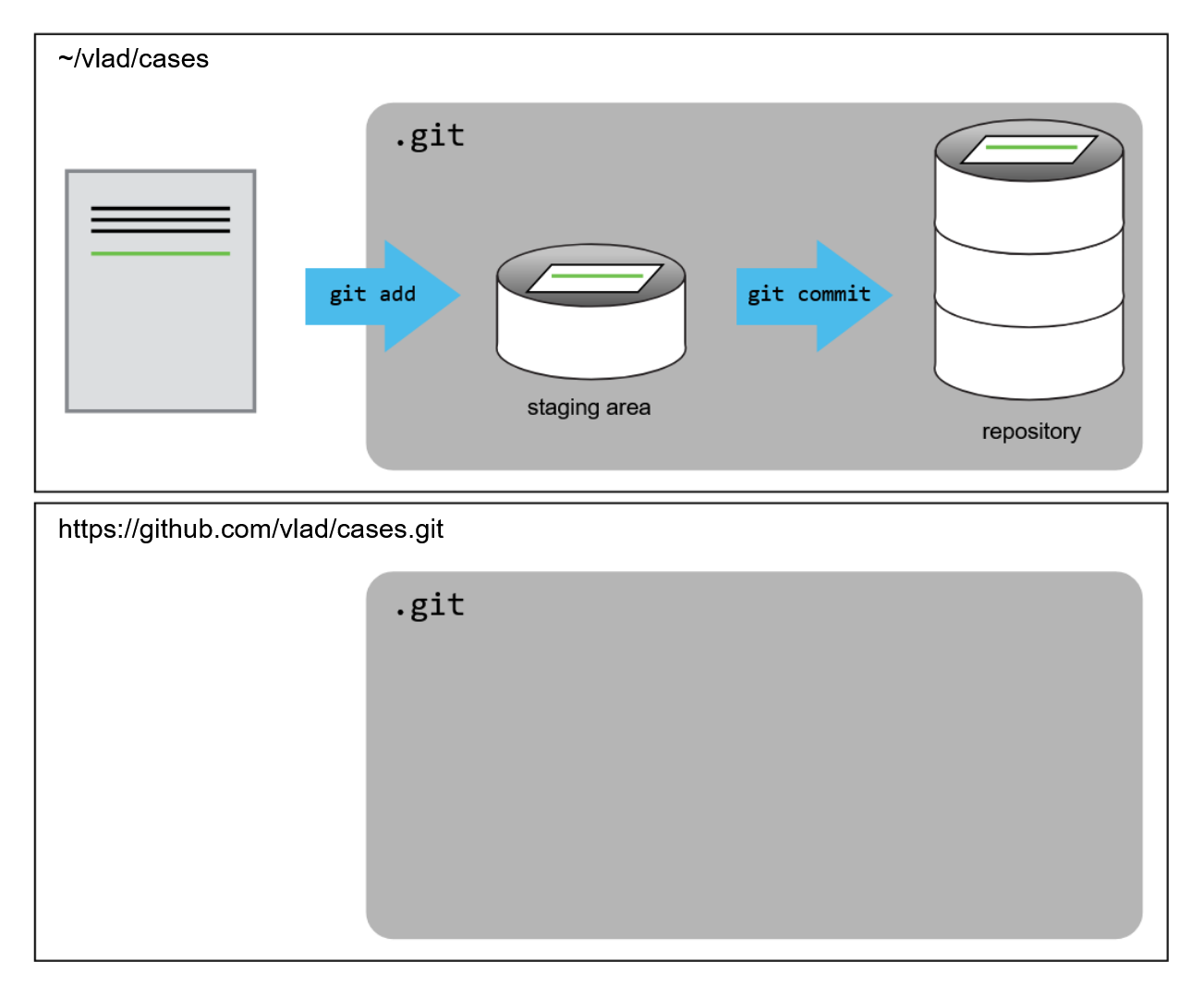
Note that our local repository still contains our earlier work on
sitrep.Rmd, but the remote repository on GitHub appears
empty as it doesn’t contain any files yet.
We’ll discuss remotes in more detail in the next episode, while talking about how they might be used for collaboration.
1. Create a remote repository
Log in to GitHub, then click on the
icon in the top right corner to create a new repository called
cases:

Name your repository cases and then click “Create
Repository”.
Note: Since this repository will be connected to a local repository, it needs to be empty. Leave “Initialize this repository with a README” unchecked, and keep “None” as options for both “Add .gitignore” and “Add a license.” See the “GitHub License and README files” exercise below for a full explanation of why the repository needs to be empty.
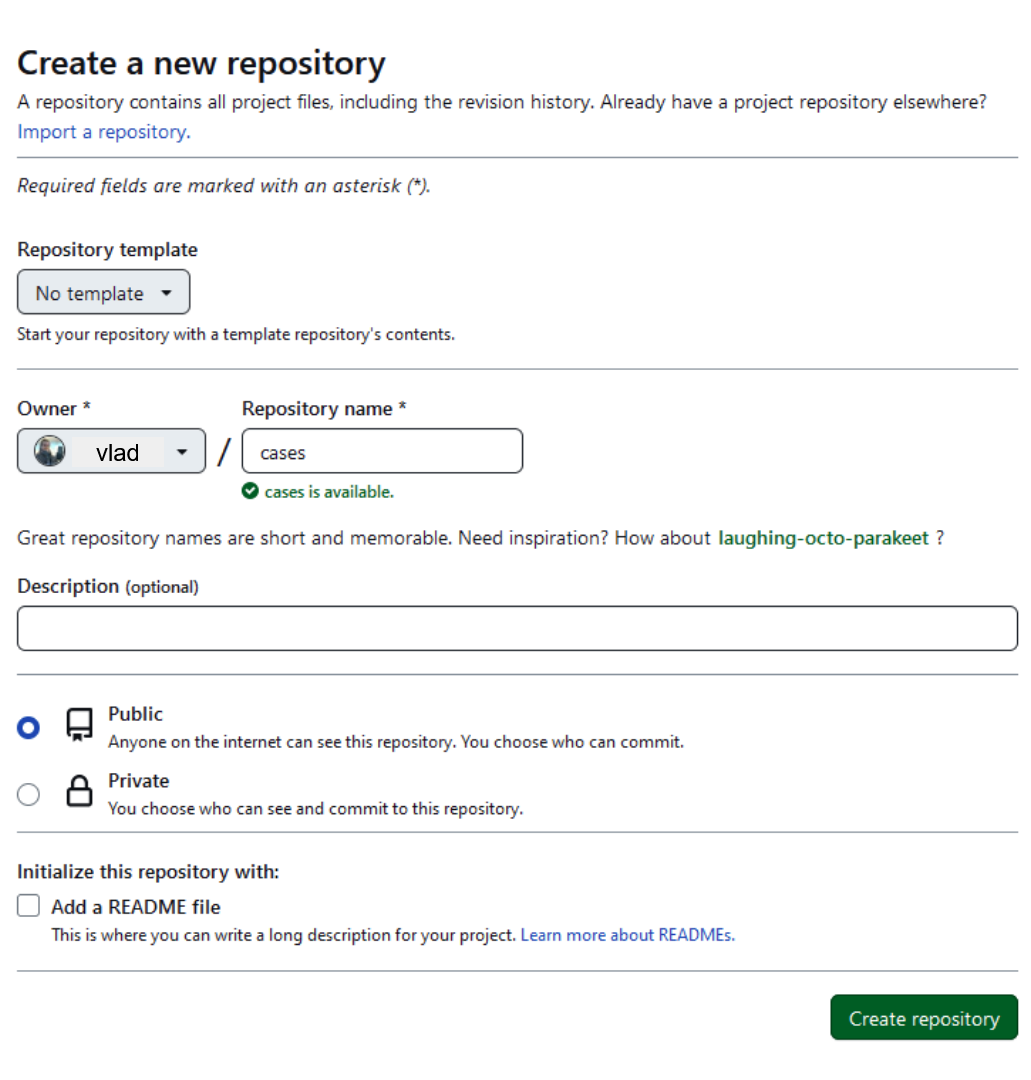
As soon as the repository is created, GitHub displays a page with a URL and some information on how to configure your local repository:
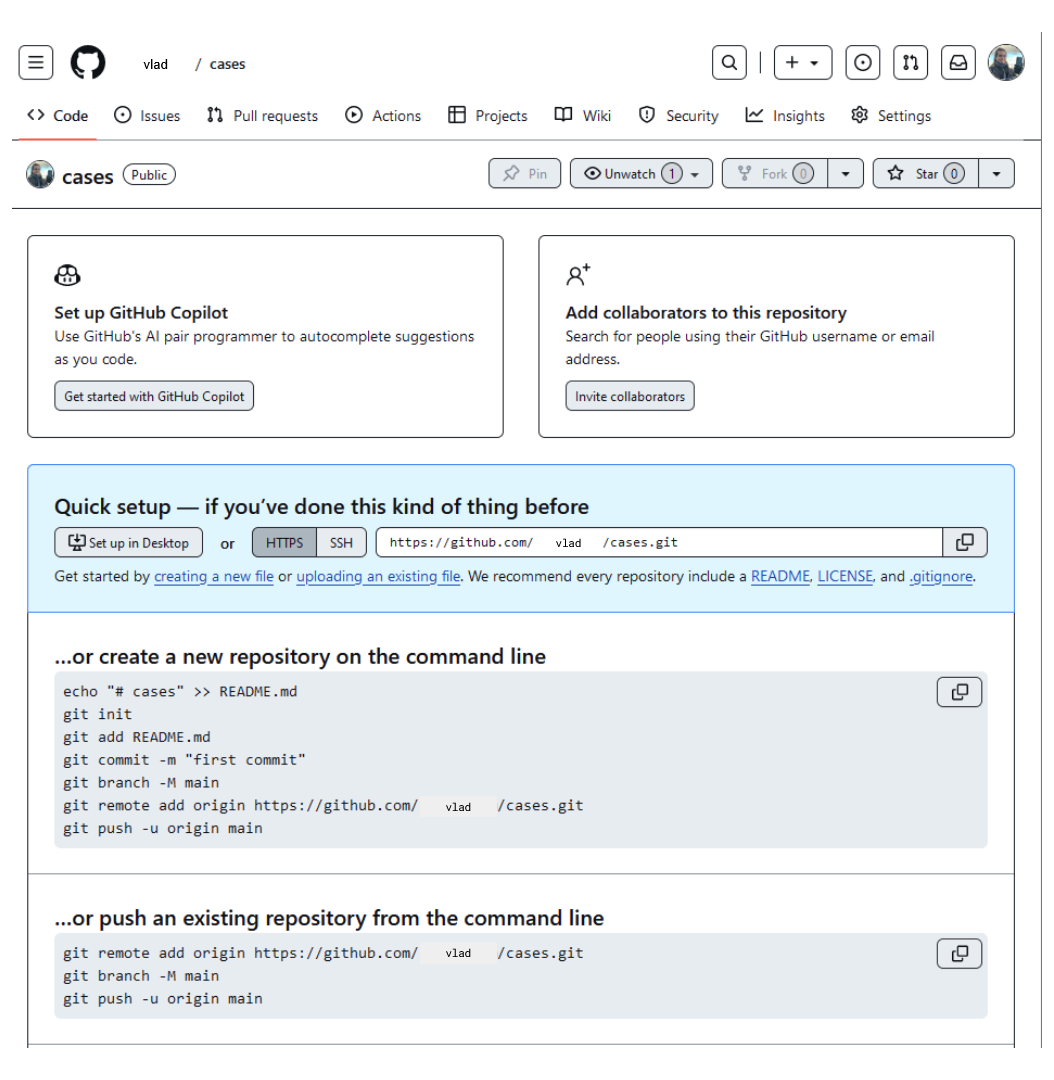
This effectively does the following on GitHub’s servers:
BASH
$ mkdir cases # creates a working directory
$ cd cases # go into cases directory
$ git init # make the cases directory a Git repositoryIf you remember back to the earlier episode where we added and committed our
earlier work on sitrep.Rmd, we had a diagram of the local
repository which looked like this:
Now that we have two repositories, we need a diagram like this:

Note that our local repository still contains our earlier work on
sitrep.Rmd, but the remote repository on GitHub appears
empty as it doesn’t contain any files yet.
2. Connect local to remote repository
Now we connect the two repositories. We do this by making the GitHub repository a remote for the local repository. The home page of the repository on GitHub includes the URL string we need to identify it:

HTTPS vs. SSH
The current recommendation is HTTPS because it is the easiest to set up on the widest range of networks and platforms, and by users who are new to all this. HTTPS is less likely to be blocked by a firewall. (StackOverflow, 2012)
Copy that URL from the browser, go into the local cases
repository, and run this command:
Make sure to use the URL for your repository rather than Vlad’s: the
only difference should be your username instead of
vlad.
origin is a local name used to refer to the remote
repository. It could be called anything, but origin is a
convention that is often used by default in git and GitHub, so it’s
helpful to stick with this unless there’s a reason not to.
We can check that the command has worked by running
git remote -v:
OUTPUT
origin git@github.com:vlad/cases.git (fetch)
origin git@github.com:vlad/cases.git (push)3. Push local changes to a remote
Now that authentication is setup, we can return to the remote. This command will push the changes from our local repository to the repository on GitHub:
Since Dracula set up a passphrase, it will prompt him for it. If you completed advanced settings for your authentication, it will not prompt for a passphrase.
OUTPUT
Enumerating objects: 16, done.
Counting objects: 100% (16/16), done.
Delta compression using up to 8 threads.
Compressing objects: 100% (11/11), done.
Writing objects: 100% (16/16), 1.45 KiB | 372.00 KiB/s, done.
Total 16 (delta 2), reused 0 (delta 0)
remote: Resolving deltas: 100% (2/2), done.
To https://github.com/vlad/cases.git
* [new branch] main -> mainPush local changes to a remote
We can add new changes to the remote repository. Let’s make a change
to sitrep.Rmd, adding yet another line.
R
usethis::edit_file("sitrep.Rmd")
OUTPUT
Comparison of attack rates in different age groups
This can identify priority groups for interventions
Maps illustrate the spread and impact of outbreak
Read shapefiles with the {sf} R packageAdd and commit this change to the local repository:
This command will push the changes from our local repository to the repository on GitHub:
Since Dracula set up a passphrase, it will prompt him for it. If you completed advanced settings for your authentication, it will not prompt for a passphrase.
OUTPUT
Enumerating objects: 16, done.
Counting objects: 100% (16/16), done.
Delta compression using up to 8 threads.
Compressing objects: 100% (11/11), done.
Writing objects: 100% (16/16), 1.45 KiB | 372.00 KiB/s, done.
Total 16 (delta 2), reused 0 (delta 0)
remote: Resolving deltas: 100% (2/2), done.
To https://github.com/vlad/cases.git
* [new branch] main -> mainIf your operating system has a password manager configured,
git push will try to use it when it needs your username and
password. For example, this is the default behavior for Git Bash on
Windows. If you want to type your username and password at the terminal
instead of using a password manager, type:
in the terminal, before you run git push. Despite the
name, Git
uses SSH_ASKPASS for all credential entry, so you may
want to unset SSH_ASKPASS whether you are using Git via SSH
or https.
You may also want to add unset SSH_ASKPASS at the end of
your ~/.bashrc to make Git default to using the terminal
for usernames and passwords.
Our local and remote repositories are now in this state:
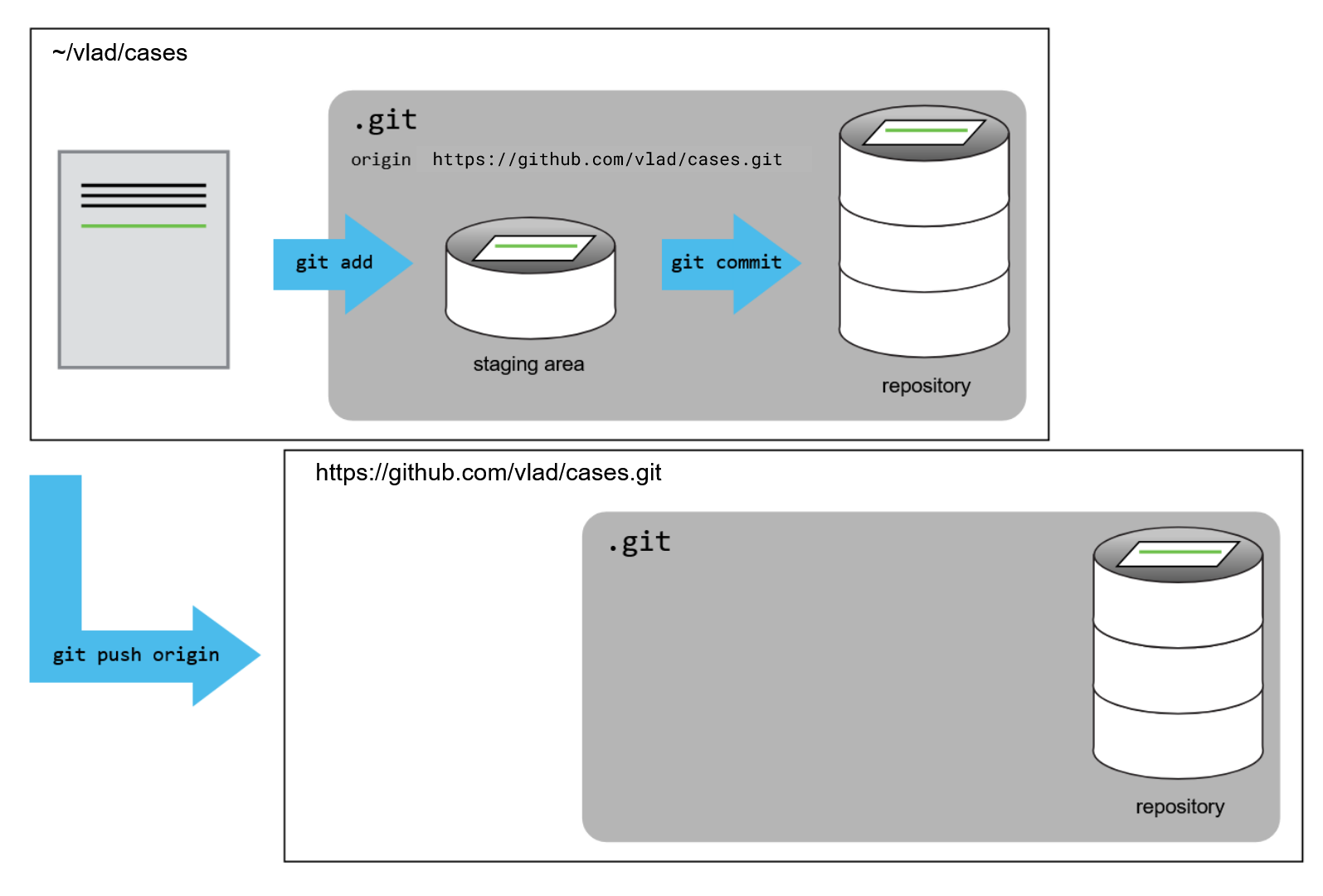
You may see a -u option used with git push
in some documentation. This option is synonymous with the
--set-upstream-to option for the git branch
command, and is used to associate the current branch with a remote
branch so that the git pull command can be used without any
arguments. To do this, simply use git push -u origin main
once the remote has been set up.
Pull changes
We can pull changes from the remote repository to the local one as well:
OUTPUT
From https://github.com/vlad/cases
* branch main -> FETCH_HEAD
Already up-to-date.Pulling has no effect in this case because the two repositories are already synchronized. If someone else had pushed some changes to the repository on GitHub, though, this command would download them to our local repository.
Group Challenges
Take 5 minutes to solve this challenge!
GitHub License and README files
In this episode we learned about creating a remote repository on GitHub, but when you initialized your GitHub repo, you didn’t add a README.md or a license file.
Create a README file in the remote repository.
Pull your changes from the remote to the local repository.
Click in the Add README option.
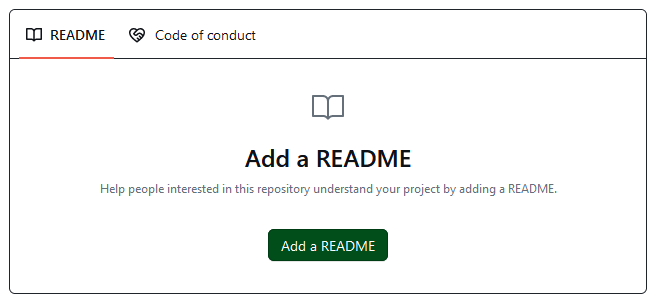
Copy and paste this minimal template of a README.md
file:
# Situational Report
This is a report for a disease outbreak investigation by Outbreak Missions.
## Files
- sitrep.Rmd
## Authors
- Wolfman
- DraculaTo pull changes from remote to local, use this command:
If you are interested on how to write good READMEs, we invite you to review a dedicated episode in the Improve your code for Epidemic Analysis with R tutorial website!
Checklist

git pull to download content
from a remote repository to the workspace and update the local
repository to match that content. Use git push to upload
local repository content to a remote repository.Individual Challenges
Challenge
For the Outbreak response, along with tracking information about cases (the project we have already created), Dracula would also like to track information about interventions.
Create new local repository for
interventionsand connect it with a remote repository.Create a
read-data.Rfile.Add and commit that change to the local repository.
Push that change to the remote repository.
First, if you are in RStudio, close your R Project from
File > Close Project.
In the Console, run:
R
# create a new R project in a new directory
usethis::create_project(path = "interventions")
# make the interventions directory a Git local repository
usethis::use_git()
# 1. create a GitHub remote repository
# 2. connect local with remote
# 3. push content to remote
usethis::use_github()
Create the file
R
usethis::edit_file("read-data.R")
In the Terminal, run:
GitHub GUI
Browse to your cases repository on GitHub. Underneath
the Code button, find and click on the text that says “XX commits”
(where “XX” is some number). Hover over, and click on, the three buttons
to the right of each commit. What information can you gather/explore
from these buttons? How would you get that same information in the
shell?
The left-most button (with the picture of a clipboard) copies the
full identifier of the commit to the clipboard. In the shell,
git log will show you the full commit identifier for each
commit.
When you click on the middle button, you’ll see all of the changes
that were made in that particular commit. Green shaded lines indicate
additions and red ones removals. In the shell we can do the same thing
with git diff. In particular,
git diff ID1..ID2 where ID1 and ID2 are commit identifiers
(e.g. git diff a3bf1e5..041e637) will show the differences
between those two commits.
The right-most button lets you view all of the files in the
repository at the time of that commit. To do this in the shell, we’d
need to checkout the repository at that particular time. We can do this
with git checkout ID where ID is the identifier of the
commit we want to look at. If we do this, we need to remember to put the
repository back to the right state afterwards!
Uploading files directly in GitHub browser
Github also allows you to skip the command line and upload files directly to your repository without having to leave the browser. There are two options. First you can click the “Upload files” button in the toolbar at the top of the file tree. Or, you can drag and drop files from your desktop onto the file tree. You can read more about this on this GitHub page.
GitHub Timestamp
Create a remote repository on GitHub. Push the contents of your local repository to the remote. Make changes to your local repository and push these changes. Go to the repo you just created on GitHub and check the timestamps of the files. How does GitHub record times, and why?
GitHub displays timestamps in a human readable relative format (i.e. “22 hours ago” or “three weeks ago”). However, if you hover over the timestamp, you can see the exact time at which the last change to the file occurred.
Push vs. Commit
In this episode, we introduced the “git push” command. How is “git push” different from “git commit”?
When we push changes, we’re interacting with a remote repository to update it with the changes we’ve made locally (often this corresponds to sharing the changes we’ve made with others). Commit only updates your local repository.
Key Points
- A local Git repository can be connected to one or more remote repositories.
- Use
usethis::use_github()to connect to a remote repository. -
git pushcopies changes from a local repository to a remote repository. -
git pullcopies changes from a remote repository to a local repository.
